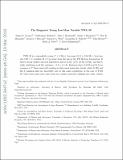THE ENIGMATIC YOUNG, LOW-MASS VARIABLE TWA 30
Author(s)
Looper, Dagny L.; Mohanty, Subhanjoy; Bochanski, John J.; Burgasser, Adam J.; Mamajek, Eric E.; Herczeg, Gregory J.; West, Andrew A.; Faherty, Jacqueline K.; Rayner, John; Pitts, Mark A.; Kirkpatrick, J. Davy; ... Show more Show less
DownloadBurgasser_The enigmatic.pdf (1.903Mb)
OPEN_ACCESS_POLICY
Open Access Policy
Creative Commons Attribution-Noncommercial-Share Alike
Terms of use
Metadata
Show full item recordAbstract
TWA 30 is a remarkable young (7 ± 3 Myr), low-mass (0.12 ± 0.04 M [subscript ☉]), late-type star (M5 ± 1) residing 42 ± 2 pc away from the Sun in the TW Hydrae Association (TWA). It shows strong outflow spectral signatures such as [S II], [O I], [O II], [O III], and Mg I], while exhibiting weak Hα emission (–6.8 ± 1.2 Å). Emission lines of [S II] and [O I] are common to T Tauri stars still residing in their natal molecular clouds, while [O III] and Mg I] emission lines are incredibly rare in this same population; in the case of TWA 30, these latter lines may arise from new outflow material colliding into older outflow fronts. The weak Hα emission and small radial velocity shifts of line emission relative to the stellar frame of rest (generally [less than and approximately equal to] 10 km s[superscript –1]) suggest that the disk is viewed close to edge-on and that the stellar axis may be inclined to the disk, similar to the AA Tau system, based on its temporal changes in emission/absorption line strengths/profiles and variable reddening (A V = 1.5-9.0). The strong Li absorption (0.61 ± 0.13 Å) and common kinematics with members of the TWA confirm its age and membership to the association. Given the properties of this system such as its proximity, low mass, remarkable outflow signatures, variability, and edge-on configuration, this system is a unique case study at a critical time in disk evolution and planet-building processes.
Date issued
2010-05Department
MIT Kavli Institute for Astrophysics and Space ResearchJournal
The Astrophysical Journal
Citation
Looper, Dagny L., Subhanjoy Mohanty, John J. Bochanski, Adam J. Burgasser, Eric E. Mamajek, Gregory J. Herczeg, Andrew A. West, et al. “THE ENIGMATIC YOUNG, LOW-MASS VARIABLE TWA 30.” The Astrophysical Journal 714, no. 1 (May 1, 2010): 45–67.
Version: Author's final manuscript
ISSN
0004-637X
1538-4357